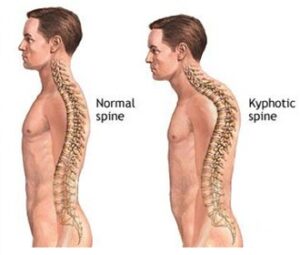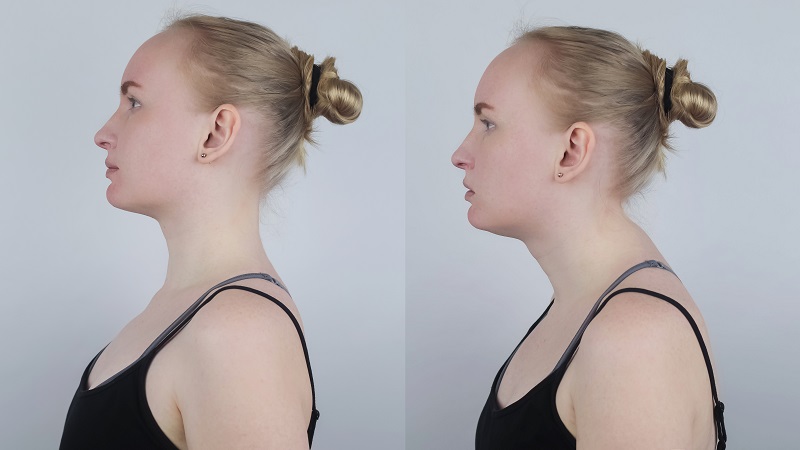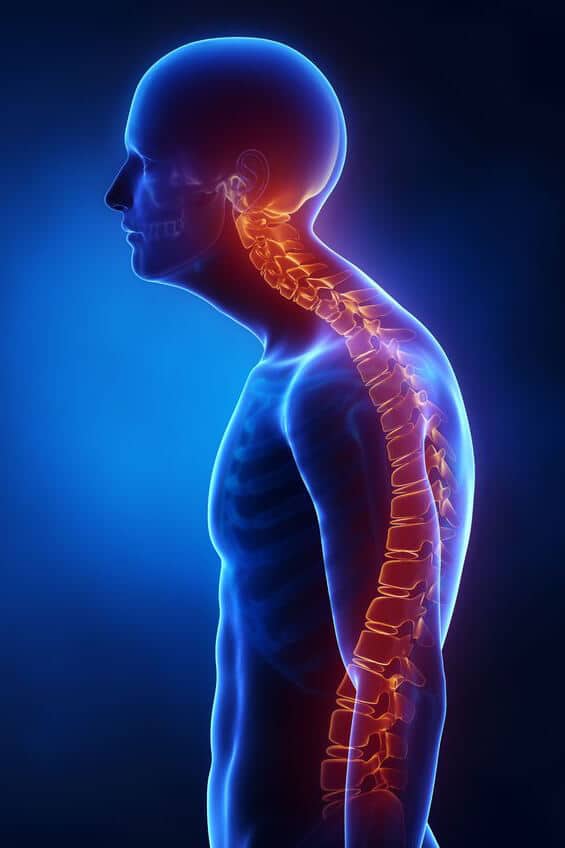
Discover effective strategies to manage and prevent Dowager’s Hump. Learn about its causes, symptoms, treatments, and lifestyle changes to maintain a healthier spine.
Introduction
Dowager’s Hump is more than just a cosmetic issue; it’s a condition that affects the structure and health of the spine. Characterized by an abnormal outward curvature of the thoracic vertebrae, Dowager’s Hump is commonly seen as a rounded hunch in the upper back. This condition is often associated with aging, particularly in postmenopausal women, but it can affect individuals of all ages. The term “dowager” historically refers to an elderly woman of high social status, reflecting the common association of this condition with older women. However, it’s important to recognize that Dowager’s Hump can develop due to various factors, including poor posture, osteoporosis, and spinal degeneration. Understanding the underlying causes and symptoms is crucial for effective management and prevention.
The Anatomy Behind Dowager’s Hump
To fully grasp what Dowager’s Hump is, it’s essential to understand the anatomy of the spine. The spine is composed of 33 vertebrae, divided into several regions: cervical (neck), thoracic (upper and mid-back), lumbar (lower back), sacral (pelvic area), and coccygeal (tailbone). Dowager’s Hump primarily affects the thoracic region, where the vertebrae are naturally curved outward to a slight degree. However, when this curve becomes exaggerated, it leads to kyphosis, or what is commonly known as Dowager’s Hump. This excessive curvature can put pressure on the spine and surrounding muscles, leading to discomfort, pain, and a noticeable change in posture. The condition can also affect the cervical region, causing the head to protrude forward, further exacerbating the hunchback appearance.
Causes of Dowager’s Hump: A Closer Look
The development of Dowager’s Hump can be attributed to a combination of factors, including age-related changes, osteoporosis, poor posture, and spinal injuries. As we age, the bones and discs in the spine can weaken and lose their structural integrity, making them more susceptible to deformities like kyphosis. Osteoporosis, a condition characterized by the loss of bone density, plays a significant role in the development of Dowager’s Hump. When the bones in the spine become brittle, they are more likely to fracture or collapse, leading to a forward curvature. Additionally, poor posture, particularly slouching or sitting for prolonged periods, can contribute to the development of Dowager’s Hump. Over time, habitual poor posture can weaken the muscles that support the spine, causing the thoracic vertebrae to curve abnormally. Spinal injuries or conditions such as Scheuermann’s disease can also lead to the onset of Dowager’s Hump.
Recognizing the Symptoms of Dowager’s Hump
Identifying the symptoms of Dowager’s Hump early on is crucial for timely intervention and treatment. The most obvious symptom is the visible hump on the upper back, typically accompanied by a forward head posture. However, Dowager’s Hump can also cause other symptoms that may affect daily life. These include chronic back pain, particularly in the upper back and neck, stiffness or tightness in the spine, and difficulty maintaining an upright posture. In more severe cases, Dowager’s Hump can lead to reduced lung capacity and breathing difficulties due to the pressure on the chest cavity. Additionally, some individuals may experience headaches or migraines as a result of the forward head posture, which can strain the neck muscles. Recognizing these symptoms early allows for prompt medical attention and the development of a treatment plan to manage the condition effectively.
The Impact of Dowager’s Hump on Quality of Life
Living with Dowager’s Hump can significantly impact a person’s quality of life, both physically and emotionally. The physical discomfort associated with the condition, such as chronic pain and stiffness, can make it difficult to perform everyday activities. Simple tasks like lifting objects, standing for extended periods, or even sitting comfortably can become challenging. Additionally, the visible hunchback appearance can affect self-esteem and body image, leading to feelings of embarrassment or social withdrawal. This emotional impact is particularly pronounced in individuals who develop Dowager’s Hump at a younger age. Furthermore, the forward head posture associated with the condition can lead to additional health issues, such as tension headaches and temporomandibular joint (TMJ) disorders. Understanding the wide-ranging effects of Dowager’s Hump underscores the importance of seeking treatment and making lifestyle changes to improve overall well-being.
Diagnosing Dowager’s Hump: What to Expect
If you suspect you have Dowager’s Hump, a thorough medical evaluation is essential for an accurate diagnosis. The diagnostic process typically begins with a physical examination, during which a healthcare provider will assess your posture, spinal alignment, and range of motion. They may ask you to perform certain movements or positions to evaluate the flexibility of your spine. Additionally, your medical history will be reviewed to identify any underlying conditions or risk factors that may contribute to the development of Dowager’s Hump. In some cases, imaging tests such as X-rays, MRI, or CT scans may be ordered to provide a detailed view of the spine and confirm the diagnosis. These tests can reveal the degree of spinal curvature, the condition of the vertebrae and discs, and any potential complications, such as fractures or nerve compression. Early diagnosis is key to preventing the progression of Dowager’s Hump and developing an effective treatment plan.

Treatment Options for Dowager’s Hump: An Overview
Treating Dowager’s Hump requires a multifaceted approach that addresses both the underlying causes and the symptoms of the condition. The goal of treatment is to reduce the curvature, alleviate pain, and improve posture. One of the most common treatment options is physical therapy, which focuses on strengthening the muscles that support the spine and improving flexibility. A physical therapist may design a personalized exercise program that includes stretches, strength training, and posture correction exercises. Additionally, lifestyle changes, such as maintaining a healthy weight and practicing good posture, are essential components of treatment. For individuals with osteoporosis-related Dowager’s Hump, medications to strengthen bone density may be prescribed. In more severe cases, where the curvature is causing significant pain or affecting lung function, surgical intervention may be considered. Surgery typically involves spinal fusion, where the affected vertebrae are fused together to reduce the curvature and stabilize the spine.
The Role of Physical Therapy in Managing Dowager’s Hump
Physical therapy plays a crucial role in managing Dowager’s Hump, particularly in the early stages of the condition. Through targeted exercises and manual therapy techniques, physical therapy can help strengthen the muscles that support the spine, improve posture, and increase flexibility. One of the key components of physical therapy for Dowager’s Hump is posture correction. A physical therapist will work with you to identify and correct any postural habits that may be contributing to the curvature. This may involve exercises to strengthen the core muscles, which play a vital role in supporting the spine. Additionally, stretching exercises can help improve the flexibility of the spine and reduce stiffness. In some cases, manual therapy techniques, such as spinal mobilization or massage, may be used to relieve muscle tension and improve spinal alignment. Consistency is key to achieving the best results with physical therapy, so it’s important to follow your therapist’s recommendations and practice the exercises regularly.
Posture Correction: A Key to Preventing Dowager’s Hump
Good posture is one of the most effective ways to prevent and manage Dowager’s Hump. Proper alignment of the spine helps distribute weight evenly and reduces the risk of developing an abnormal curvature. To maintain good posture, it’s important to be mindful of your body position throughout the day. When sitting, ensure that your back is straight, your shoulders are relaxed, and your feet are flat on the floor. Avoid slouching or leaning forward, as this can place unnecessary strain on the thoracic vertebrae. When standing, keep your head aligned with your spine, and avoid jutting your chin forward. It’s also important to take regular breaks if you sit for prolonged periods, as this can help prevent stiffness and muscle imbalances. Incorporating posture-friendly habits into your daily routine can go a long way in preventing the development or progression of Dowager’s Hump.
Exercises to Combat Dowager’s Hump: Strengthening the Spine
Regular exercise is essential for managing Dowager’s Hump and improving spinal health. Specific exercises that target the muscles of the upper back, neck, and core can help reduce the curvature and alleviate symptoms. One effective exercise is the chin tuck, which helps strengthen the muscles at the front of the neck and improve head alignment. To perform a chin tuck, simply pull your chin backward, as if you’re trying to create a double chin, and hold for a few seconds. Another beneficial exercise is the wall angel, which involves standing with your back against a wall and slowly raising and lowering your arms to strengthen the upper back muscles. Additionally, exercises like the cat-cow stretch and the thoracic extension can help improve spinal flexibility and reduce stiffness. It’s important to perform these exercises regularly and under the guidance of a healthcare professional to ensure proper form and avoid injury.
The Importance of Bone Health in Preventing Dowager’s Hump
Maintaining strong bones is crucial for preventing the development of Dowager’s Hump, especially in individuals at risk for osteoporosis. Bone health can be supported through a combination of diet, exercise, and lifestyle choices. A diet rich in calcium and vitamin D is essential for maintaining bone density and strength. Calcium is the primary building block of bones, while vitamin D helps the body absorb calcium effectively. Foods like dairy products, leafy greens, and fortified cereals are excellent sources of calcium, while sunlight exposure and supplements can help ensure adequate vitamin D levels. Weight-bearing exercises, such as walking, jogging, and resistance training, are also important for bone health, as they stimulate bone formation and strengthen the muscles that support the spine. Additionally, avoiding smoking and excessive alcohol consumption can help protect bone health and reduce the risk of osteoporosis, which is a leading cause of Dowager’s Hump.
Surgical Options for Severe Dowager’s Hump
In cases where Dowager’s Hump is severe and causing significant symptoms, surgical intervention may be considered. Surgery is typically recommended when the curvature is severe, causing pain, nerve compression, or respiratory issues. The most common surgical procedure for Dowager’s Hump is spinal fusion, which involves fusing the affected vertebrae together to reduce the curvature and stabilize the spine. During the procedure, the surgeon may use metal rods, screws, or bone grafts to hold the vertebrae in place while they heal and fuse. While spinal fusion can be effective in reducing the curvature and relieving symptoms, it is a major surgery with potential risks, such as infection, nerve damage, or reduced spinal flexibility. Therefore, it is usually considered only after other treatment options have been exhausted. Recovery from spinal fusion surgery can take several months, and physical therapy is often recommended to help regain strength and mobility.
Dowager’s Hump in Younger Individuals: Causes and Prevention
While Dowager’s Hump is most commonly associated with older adults, it can also develop in younger individuals. In younger people, Dowager’s Hump is often related to poor posture, particularly from prolonged sitting or slouching. The increasing use of computers and mobile devices has led to a rise in cases of forward head posture and kyphosis among younger generations. To prevent the development of Dowager’s Hump in younger individuals, it’s important to encourage good posture habits from an early age. This includes maintaining a neutral spine position when sitting or standing, taking regular breaks from sitting, and incorporating physical activity into daily routines. Additionally, strength training and flexibility exercises can help build strong muscles that support the spine and reduce the risk of developing an abnormal curvature. By addressing posture and promoting spinal health early on, younger individuals can reduce their risk of developing Dowager’s Hump later in life.

Lifestyle Changes to Manage and Prevent Dowager’s Hump
Making certain lifestyle changes can play a significant role in managing and preventing Dowager’s Hump. One of the most important changes is maintaining a healthy weight, as excess body weight can place additional strain on the spine and contribute to the development of kyphosis. Regular physical activity, including exercises that strengthen the core and upper back muscles, is essential for supporting spinal health. Additionally, it’s important to practice good posture habits throughout the day, whether sitting, standing, or lying down. Ergonomic adjustments, such as using a supportive chair, adjusting the height of your computer monitor, and avoiding prolonged periods of sitting, can also help reduce the strain on your spine. If you smoke, quitting smoking can improve bone health and reduce the risk of osteoporosis, which is a major factor in the development of Dowager’s Hump. Finally, regular check-ups with a healthcare provider can help monitor your spinal health and catch any potential issues early on.
The Psychological Impact of Dowager’s Hump
Beyond the physical symptoms, Dowager’s Hump can have a significant psychological impact on those affected. The visible curvature of the spine can affect self-esteem and body image, leading to feelings of self-consciousness or embarrassment. This is especially true for younger individuals who may feel that their appearance is not in line with societal standards of beauty. Additionally, the chronic pain and discomfort associated with Dowager’s Hump can lead to frustration and a decreased quality of life. It’s important for individuals with Dowager’s Hump to seek emotional support, whether through counseling, support groups, or talking with loved ones. Addressing the emotional impact of the condition is an important part of overall management and can help individuals maintain a positive outlook and engage in treatment more effectively.
Dowager’s Hump and Aging: What to Expect
As we age, the risk of developing Dowager’s Hump increases due to age-related changes in the spine and bones. Osteoporosis, which is common in older adults, is a major risk factor for the development of kyphosis. As bone density decreases, the vertebrae can become more susceptible to fractures, leading to a forward curvature of the spine. Additionally, the muscles and ligaments that support the spine can weaken with age, further contributing to the development of Dowager’s Hump. It’s important for older adults to take proactive steps to maintain spinal health, including engaging in regular physical activity, maintaining a healthy diet rich in calcium and vitamin D, and practicing good posture. Regular bone density screenings and check-ups with a healthcare provider can also help identify and address any issues early on.
The Connection Between Dowager’s Hump and Osteoporosis
Osteoporosis is a major contributing factor to the development of Dowager’s Hump. This condition, characterized by a loss of bone density and strength, makes the bones in the spine more susceptible to fractures. When the vertebrae in the thoracic region weaken or collapse due to osteoporosis, it can lead to an exaggerated forward curvature, resulting in Dowager’s Hump. Women, particularly postmenopausal women, are at a higher risk of developing osteoporosis and, consequently, Dowager’s Hump. To reduce the risk, it’s important to maintain good bone health through a diet rich in calcium and vitamin D, regular weight-bearing exercise, and lifestyle choices such as not smoking and limiting alcohol consumption. For those already diagnosed with osteoporosis, medications may be prescribed to strengthen bones and reduce the risk of fractures, which can help prevent the progression of Dowager’s Hump.
The Role of Nutrition in Preventing Dowager’s Hump
Proper nutrition plays a vital role in preventing Dowager’s Hump by supporting bone health and overall spinal integrity. A diet rich in calcium and vitamin D is essential for maintaining strong bones and reducing the risk of osteoporosis, a leading cause of Dowager’s Hump. Calcium is found in foods like dairy products, leafy greens, and fortified cereals, while vitamin D can be obtained from sunlight exposure and supplements. In addition to calcium and vitamin D, other nutrients such as magnesium, potassium, and vitamin K are important for bone health. These nutrients can be found in a variety of foods, including nuts, seeds, fruits, and vegetables. Maintaining a balanced diet that provides these essential nutrients can help keep your bones strong and reduce the risk of developing Dowager’s Hump. It’s also important to stay hydrated, as dehydration can affect the discs in the spine and contribute to spinal problems.
Dowager’s Hump in Men: A Growing Concern
While Dowager’s Hump is often associated with women, particularly postmenopausal women, it can also affect men. In men, the condition may be less common, but it is still a significant concern, particularly as they age. Factors such as poor posture, spinal injuries, and osteoporosis can contribute to the development of Dowager’s Hump in men. Additionally, lifestyle factors such as smoking, excessive alcohol consumption, and a sedentary lifestyle can increase the risk. It’s important for men to be aware of the signs and symptoms of Dowager’s Hump and take steps to maintain spinal health. This includes engaging in regular physical activity, practicing good posture, maintaining a healthy diet rich in bone-supporting nutrients, and avoiding habits that can weaken bones. Regular check-ups with a healthcare provider can also help detect any early signs of spinal problems and allow for prompt intervention.
Myths and Misconceptions About Dowager’s Hump
There are several myths and misconceptions surrounding Dowager’s Hump that can lead to misunderstanding or stigma. One common misconception is that Dowager’s Hump is simply a natural part of aging and cannot be prevented or treated. While it is true that age-related changes can increase the risk of developing Dowager’s Hump, the condition is not inevitable, and there are effective ways to prevent and manage it. Another myth is that Dowager’s Hump is purely a cosmetic issue and does not cause any physical discomfort. In reality, Dowager’s Hump can lead to significant pain, stiffness, and even breathing difficulties in severe cases. Additionally, some people believe that only women can develop Dowager’s Hump, but the condition can affect both men and women. By debunking these myths and promoting accurate information, we can encourage more people to take proactive steps in managing and preventing Dowager’s Hump.

Seeking Professional Help for Dowager’s Hump
If you suspect that you have Dowager’s Hump or are experiencing symptoms such as chronic back pain, stiffness, or a noticeable curvature of the spine, it’s important to seek professional help. A healthcare provider can perform a thorough evaluation to diagnose the condition and recommend appropriate treatment options. Early intervention is key to preventing the progression of Dowager’s Hump and managing symptoms effectively. Treatment may involve a combination of physical therapy, lifestyle changes, medication, or in severe cases, surgery. Additionally, a healthcare provider can offer guidance on posture correction, exercises, and nutritional recommendations to support spinal health. Don’t hesitate to reach out to a healthcare professional if you have concerns about Dowager’s Hump, as timely treatment can make a significant difference in your quality of life.
Conclusion
Dowager’s Hump is a condition that affects many people, particularly as they age. However, with the right knowledge and proactive steps, it is possible to manage and even prevent the development of this condition. By understanding the causes, recognizing the symptoms, and seeking appropriate treatment, individuals can maintain a healthier spine and improve their quality of life. Whether through physical therapy, lifestyle changes, or surgical intervention, there are effective ways to address Dowager’s Hump and reduce its impact. Remember, early intervention is key, so don’t hesitate to seek professional help if you suspect you may be developing Dowager’s Hump. By embracing good posture, staying active, and making informed choices about your health, you can take control of your spinal health and enjoy a more vibrant, pain-free life.
Read also: Dead Bug Exercise: Mastering Core Stability and Strength





